These soft and fluffy overnight brioche cinnamon rolls with cream cheese frosting are made from a rich, buttery brioche dough. This recipe is my love letter to the cinnamon roll from my childhood. They're made from scratch, with fluffy homemade brioche, sweet cinnamon sugar swirls, and a tangy cream cheese glaze.

I have fond memories of picking up warm, gooey cinnamon buns with my mom at the mall. After each shopping trip, we'd stop by Cinnabon and share a roll. I'd unroll it, bit by bit and savor each bite, my hands sticky from the sweet cream cheese glaze.
They're a wonderful holiday treat or cozy weekend breakfast! I can't wait to share my *absolute* favorite cinnamon roll recipe with you!
Why You'll Love This Recipe
Let me summarize what makes these homemade cinnamon rolls so special:
- The brioche dough that forms the base of the roll is made entirely from scratch with the softest, smoothest texture.
- The dough sits in the fridge overnight, so you can prepare it ahead of time and bake the rolls the next morning.
- They are the perfect treat for a Christmas brunch or lazy Sunday alongside my pumpkin spice granola, blueberry lemon pancakes, brown sugar pancakes, or sticky toffee pudding.
Characteristics of Brioche
I embarked on my journey to perfect the cinnamon brioche rolls by delving into various classic cinnamon recipes. This quest led me to one of my favorite bread-baking books, Tartine, where I discovered they used a brioche dough.
From my research, I discovered the following:
- Brioche bread is made from an enriched dough, incorporating ingredients like sugars, fats, and dairy to produce a soft, buttery texture with a fine crumb.
- It typically contains a minimum of 50% butterfat, creating a rich and indulgent pastry.
- High-fat doughs like brioche require special kneading techniques. Incorporating butter into a flour-based dough by hand can be challenging, necessitating stand mixer.
Testing Process
Next, I looked at the base pull-apart bread recipe for my garlic parmesan pull-apart rolls and jalapeno cheese buns. I compared it to a few cookbooks, like Tartine and Heritage Baking, and made some adjustments.
I increased the butter content to meet the 50% fat minimum and converted the recipe into an overnight version, ensuring the dough would be cold and manageable when shaping the rolls.
After meticulous research and testing, I pitted my modified version against Tartine's, using the same cinnamon roll filling and baking time.
The final verdict came from my husband, who enjoyed both versions but ultimately favored mine in a blind taste test. That's the version I'm sharing with you today!
Ingredient Notes
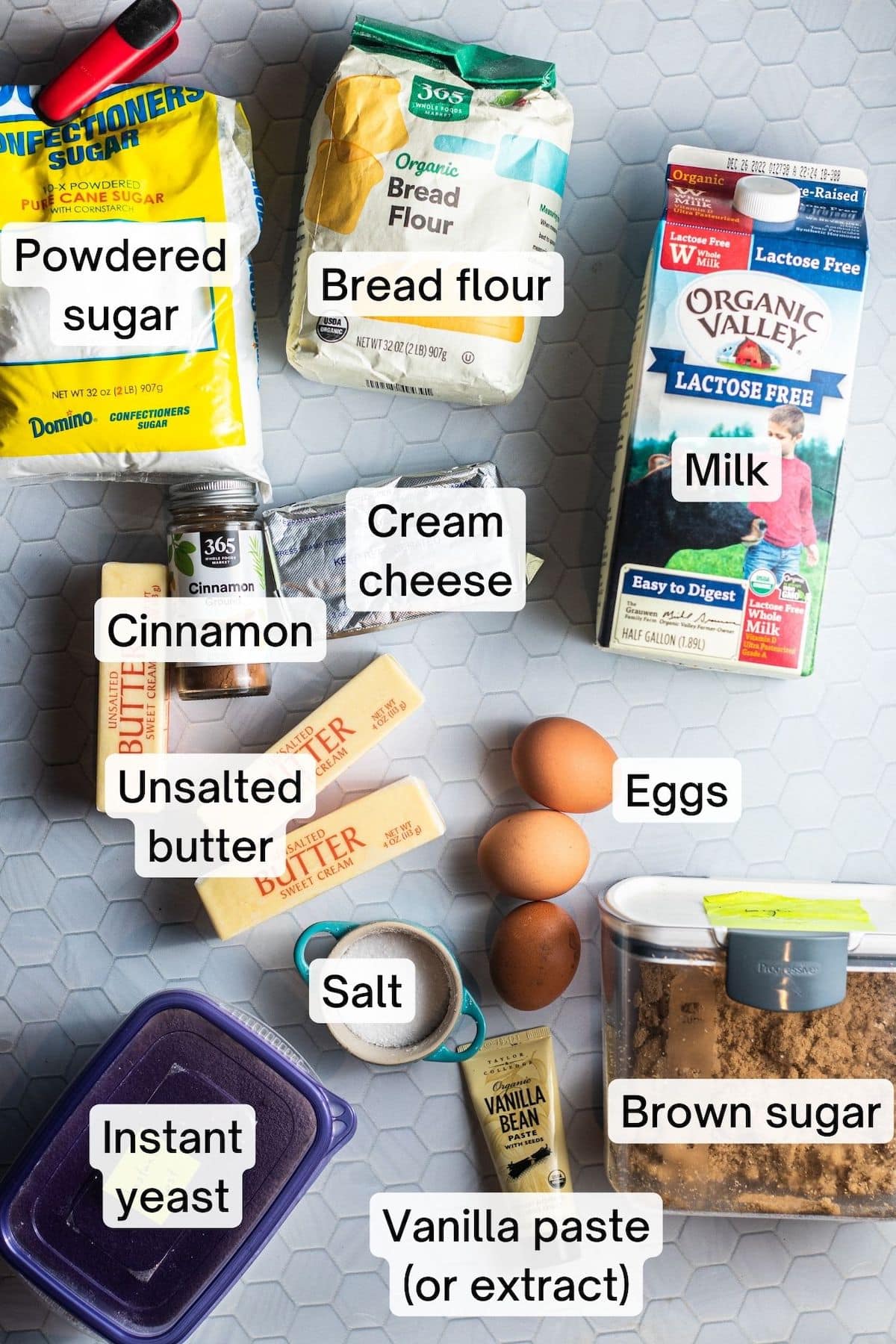
- Bread Flour: Bread flour is a common ingredient used in most bread doughs because of its high protein content, which helps create a strong gluten network and a well-structured loaf. If you can't find bread flour, you can also use King Arthur's All Purpose Flour which has a higher protein content than most AP flours.
- Instant Yeast: I typically opt for instant yeast in my bread baking because it doesn't need to be activated in liquid. My favorite brand is SAF Instant Yeast.
- Brown Sugar: Brown sugar adds a molasses-like flavor to the rolls. You can use light or dark brown sugar here.
- Vanilla Paste: Vanilla paste is a thick paste made from vanilla beans. If you don't have vanilla paste, you can substitute an equal amount of vanilla extract.
- Cream Cheese: I recommend Philadelphia Cream Cheese because it'll give you the best 'tang'.
For a full list of ingredients and their quantities, refer to the recipe card.
Step-by-Step Instructions
Make the Dough
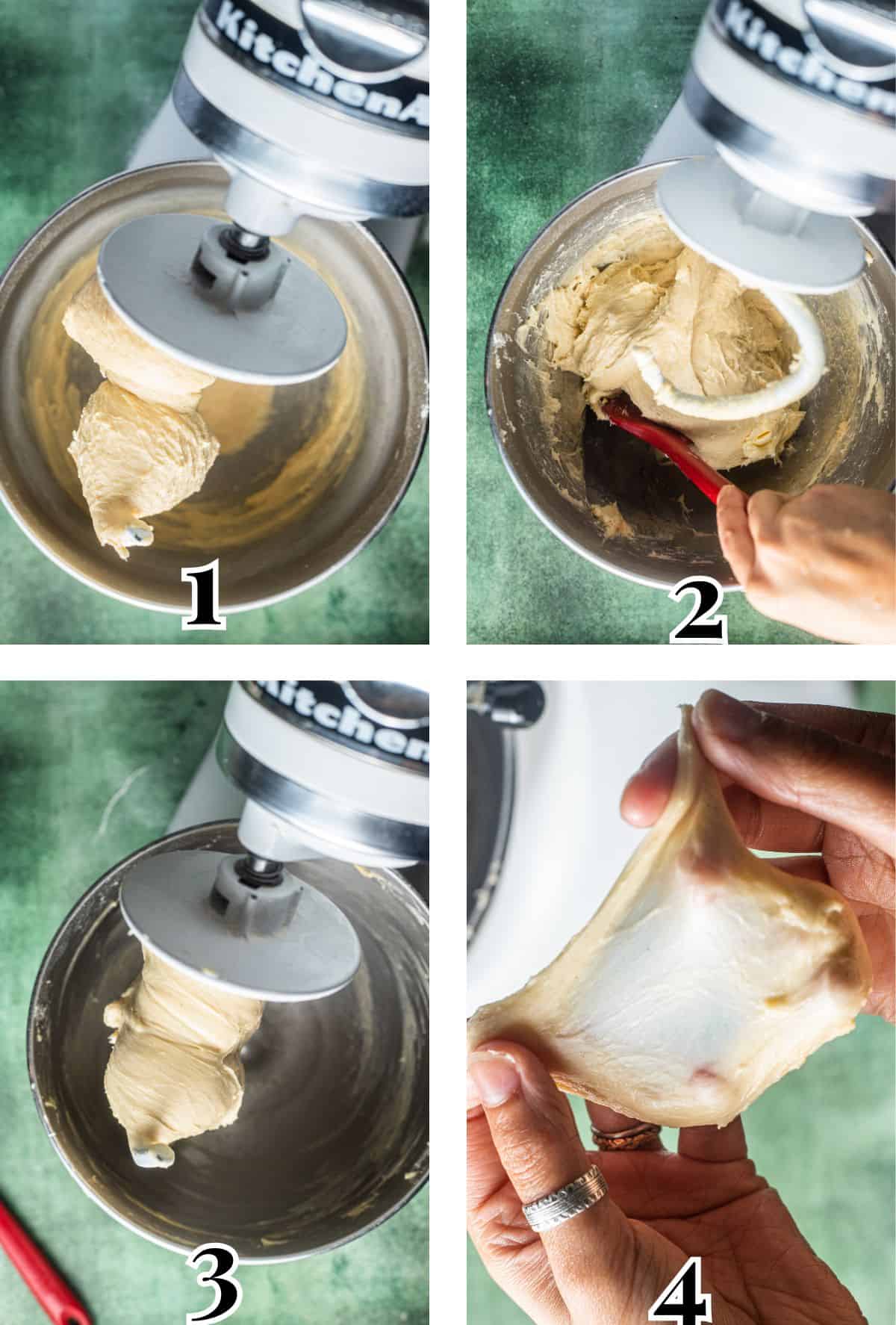
Step 1: In the bowl of a stand mixer, mix the wet ingredients until combined, followed by the dry ingredients. Knead until a sticky dough forms (Image 1).
Step 2 - Slowly add in the butter (Image 2), one piece at a time, scraping the sides of the bowl every so often. Over time your dough will transform from a wet sticky dough into a super smooth, stretchy texture (Image 3). This will take a while, so be patient!
Step 3 - Windowpane Test: When the dough is done, it should be strong enough to pass the windowpane test. This is a common test in bread baking used to determine the strength of the gluten network.
Pinch off a small piece of dough and flatten it. Place your pointer fingers on the top two corners and your pinkies on the bottom two corners. Gently stretch it with your fingers; you should be able to stretch until the dough is just barely translucent without tearing (Image 4).
Proof and Chill
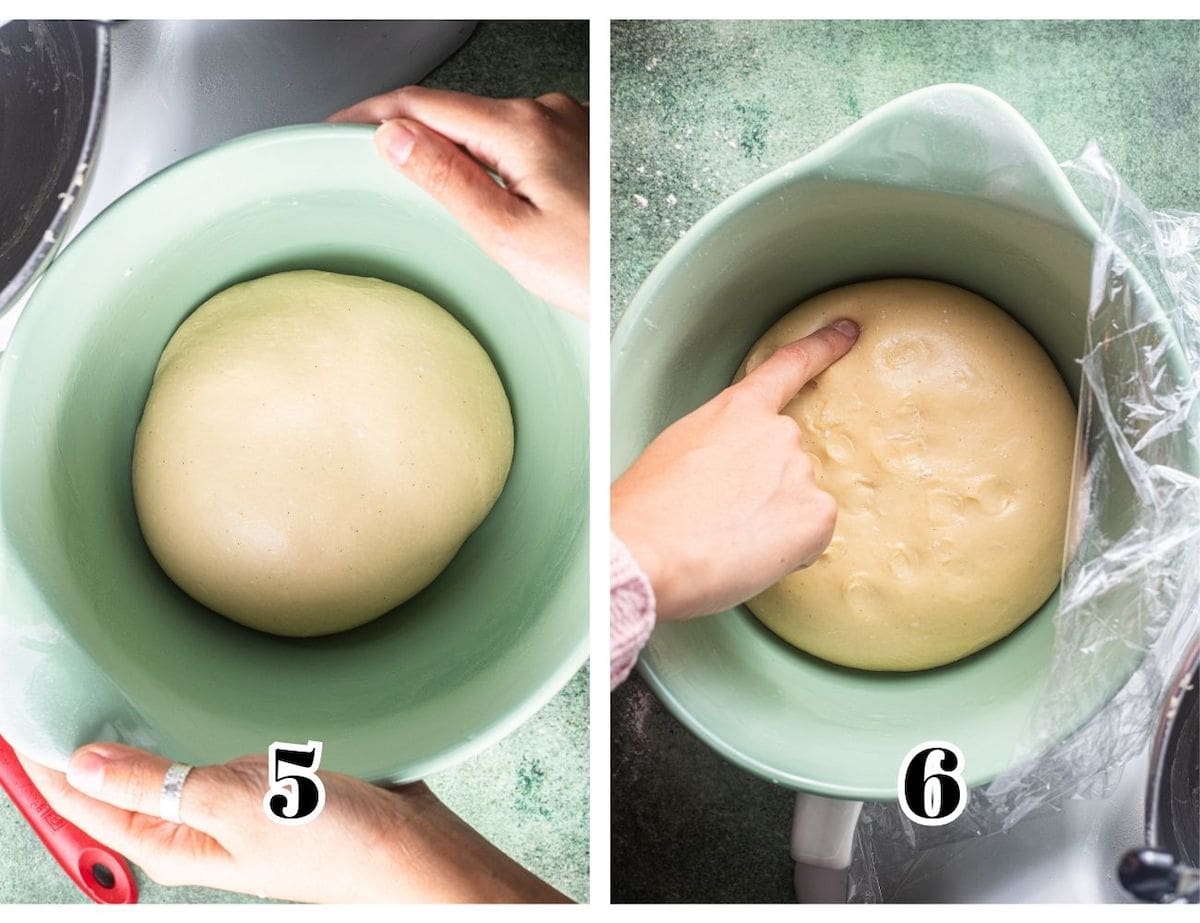
Steps 4 - Proof: Transfer to a large greased mixing bowl (Image 5) and cover with plastic wrap or a damp towel. Let the dough rise in a warm place until there are visible bubbles on the surface and it passes the "poke" test (Image 6).
What is the poke test? The poke test tells you the proofing stage of your dough. Coat your index finger in flour, then gently press your fingertip into the dough to make an indent.
If...
- The indent slowly fills back up halfway, it's perfectly proofed.
- The indent springs back quickly, it needs more time.
- The indent doesn't spring back at all, it's likely overproofed.
Step 5 - Chill: Press down on the dough to deflate and flatten it. Then chill in the fridge, covered, overnight (at least 8 hours up to 16 hours).
Note: An overnight proof offers several benefits, including added flavor and improved texture.
Roll and Fill The Buns

Step 6 - Roll Out: Remove the dough from the fridge. On a lightly floured surface, roll out the dough to a large rectangle, about 15 inches x 12 inches (Image 7). Spread with the cinnamon sugar filling (Image 8). With the short edge facing you, roll into a tight log (Images 9 & 10).
Proof and Bake

Step 7 - Proof: If needed, you can roll the log back and forth to even it out (Image 11). Trim the edges, and cut them into 9 equal pieces (Image 12). In a parchment paper lined baking pan, proof the cinnamon rolls for about 1 to 1 ½ hours until puffy (Image 13).
Step 8 - Bake: Brush heavy cream over the proofed cinnamon rolls (this helps keep them moist) and bake until golden brown (Image 14).
Glaze and Serve

Step 9 - Make the frosting: While the rolls bake, whip the cream cheese and butter together until fluffy, then add the powdered sugar, vanilla, and salt to taste.
Step 10 - Coat: Brush the hot rolls with a bit of glaze, then allow them to cool for 15 - 20 minutes until serving. Frost with the rest of the glaze and serve warm.
Tips & Tricks
Here are some tips and tricks for making the best cinnamon rolls!
- Follow the guidelines for proper proofing and gluten formation: Different variables can impact how this dough proofs, from temperature to ingredients to equipment. Always use the visual signals and tests I've provided, including the window pane test and the poke test, to assess your dough.
- Chilling is essential: Do not skip the overnight chill in this recipe! And make sure to take out the chilled, proofed overnight dough just before rolling it out. Chilled dough is much more manageable to work with.
- Glaze the cinnamon rolls twice: This is an amazing tip I learned from Sarah Kieffer's cinnamon rolls recipe. Glazing the cinnamon rolls, once hot out of the oven keeps them from drying out. A second glaze after they've cooled gives you that classic gooey, tangy bite!
Storage and Reheating Instructions
Leftover frosted cinnamon rolls can be stored at room temperature for up to 8 hours or an airtight container in the fridge for 3 - 4 days.
Reheating: The fastest way to reheat a frosted cinnamon roll is to cover it with a damp paper towel and microwave in 15-second intervals until warmed through. You can also reheat them in the oven with a sprinkle of water, covered in foil at 350°F/177°C, for 10 -15 minutes.
Recipe FAQs
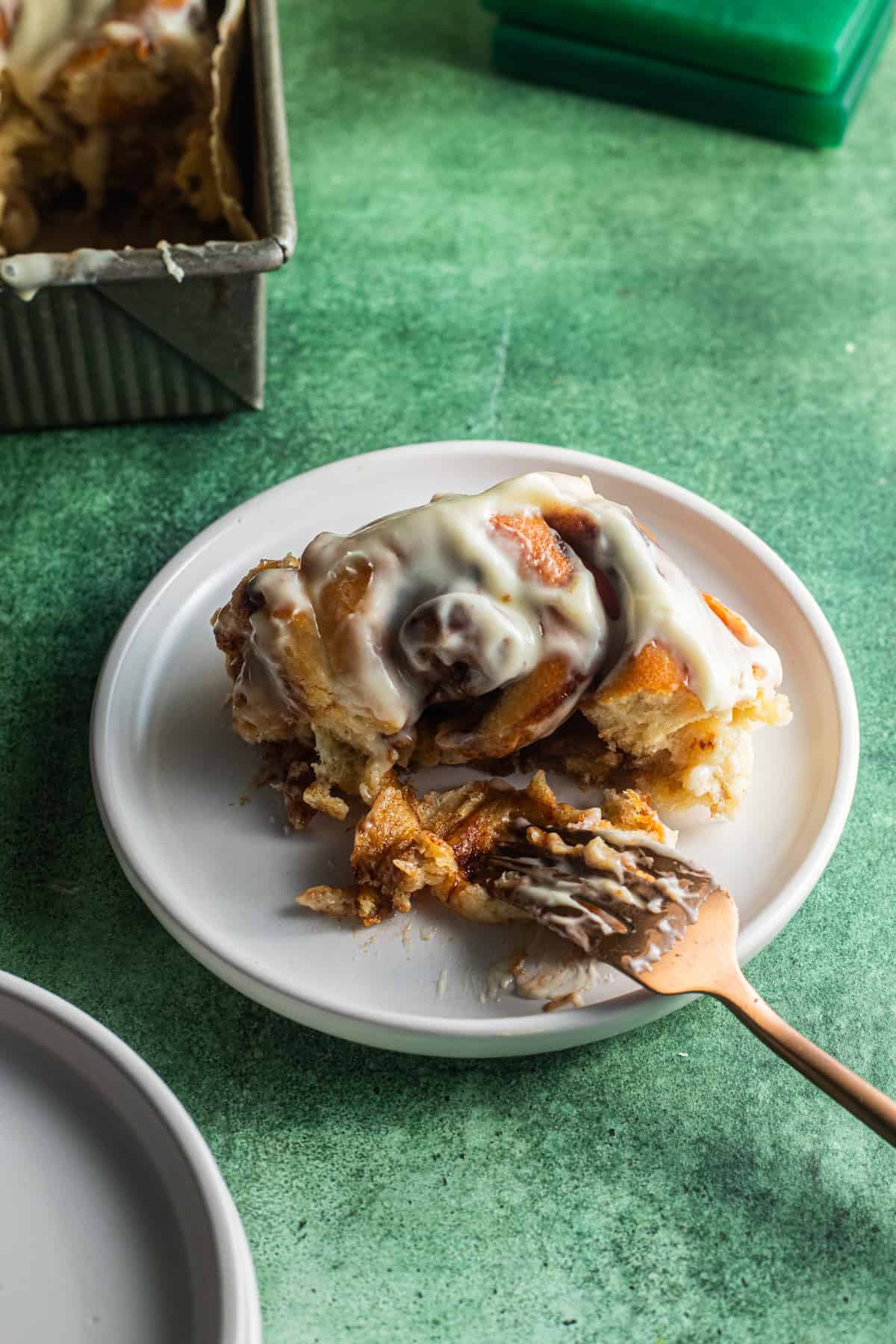
Ideally, the dough is kept between 72°F and 74°F. You can place it in a warm spot in your kitchen or in the oven (with just the oven light on).
Yes. First, increase the yeast amount by 25%. Second, before making the dough, mix the yeast into the milk and allow it to sit for 5 minutes to ensure it's activated. Finally, note that the proofing times may increase.
Yes, I highly recommend a stand mixer. It is very difficult to knead brioche by hand, especially incorporating so much butter into the dough!
The easiest way to cleanly cut cinnamon rolls is to move your knife back and forth like a saw to prevent the filling from squeezing out. You can also wrap unflavored dental floss around each portion, then pull tightly in opposing directions to slice the rolls.
If you end up overproofing the dough in the first stage (bulk rise), don’t worry too much and proceed with the rest of the recipe, though keep in mind the second rise might be shorter.
Overproofed dough during the first rise will usually end up fine as long as you don’t overproof them during the final rise (this can yield a denser roll).
Did you try this recipe?
I would love to hear your feedback! Be sure to rate the recipe and leave a comment below.
For even more cozy recipes, be sure to subscribe to my newsletter.

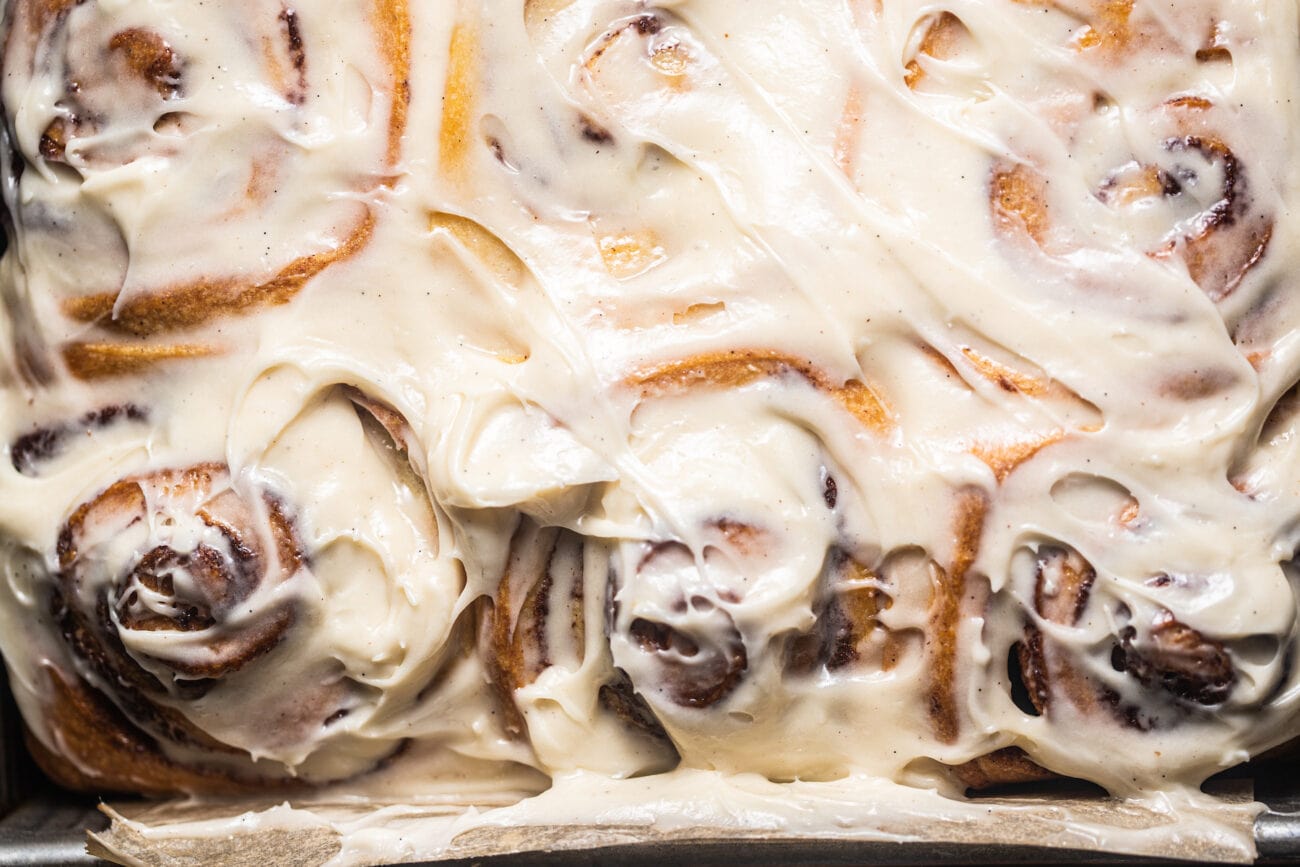
Fluffy Brioche Cinnamon Rolls
Equipment
- 8-inch by 8-inch metal baking pan, or a large cast-iron skillet or metal cake pan
- Instant Read Thermometer, optional
Ingredients
For the Dough:
- 128 grams whole milk, chilled
- 3 large eggs
- 1 ½ teaspoons vanilla paste, or vanilla extract
- 1 ¾ teaspoons instant yeast
- 370 grams bread flour, plus more for dusting
- 67 grams granulated white sugar
- 1 ½ teaspoons Diamond Crystal Kosher Salt, use half this amount if substituting with another salt
- 182 grams unsalted butter, cut into ½-inch cubes and softened to room temperature
- 30 grams heavy cream, for brushing the dough
For the Cinnamon-Sugar Filling:
- 70 grams unsalted butter, room temperature
- 150 grams brown sugar
- 1 tablespoon ground cinnamon
- Zest of 1 orange, optional
For the Cream Cheese Glaze:
- 4 ounces cream cheese, room temperature
- 56 grams unsalted butter, room temperature
- 81 grams powdered sugar
- ½ teaspoon vanilla paste, or vanilla extract
- A pinch of salt
- 1 - 2 teaspoons milk, as needed to thin out the glaze
Instructions
Make the Dough:
- In the bowl of a stand mixer fitted with the dough hook, add 128 grams whole milk, 3 large eggs, 1 ½ teaspoons vanilla paste, and 1 ¾ teaspoons instant yeast. Mix on medium speed just to break up the ingredients slightly, about 1 minute.
- Turn the mixer off, then add 370 grams bread flour, 67 grams granulated white sugar, and 1 ½ teaspoons Diamond Crystal Kosher Salt. On low speed, mix until a shaggy, sticky dough forms, about 2 minutes. Increase the speed to medium, and mix for 8 minutes until the dough is quite stretchy and sticky.
- With the mixer still on, begin adding 182 grams unsalted butter, one piece at a time. Use a flexible spatula to scrape down the sides of the bowl once half of the butter has been added.Add the rest of the butter until all of it has been incorporated, about 4 minutes.
- Continue mixing the dough for about 8 minutes, or until the dough begins vigorously slapping the sides of the bowl. The sides of the bowl should be almost completely clean.The dough should be completely homogeneous with no streaks of butter. It should be extremely soft, smooth, and tacky, and just barely sticky.
- Windowpane Test: Once the dough has met the above criteria, check that it's built up enough strength via the windowpane method. Pinch off a small piece of dough, flatten it, and gently stretch it with your fingers. The dough should become thin and translucent without tearing.
- Form the dough into a ball, then transfer to a large, lightly oiled mixing bowl. Cover with a towel or plastic wrap, and allow to rise in a warm environment (72°F/22°C to 75°F/24°C) for 1 ½ - 2 hours until proofed.Note: When properly proofed, the dough should pass the poke test. Coat your index finger in flour, then press your fingertip into the dough gently to make an indent; the indent should slowly fill back up halfway. If the indent springs back quickly, it needs more time.
- Press down on the dough to deflate and flatten it. Then chill the dough in the fridge, covered, in the mixing bowl overnight (at least 8 hours up to 24 hours).
Make the Filling:
- In the morning, mix 70 grams unsalted butter, 150 grams brown sugar, 1 tablespoon ground cinnamon, and Zest of 1 orange (if using) together in a small bowl until a paste forms. Set aside.
Roll Out and Bake:
- Remove the chilled dough from the fridge. Lightly flour a large wooden cutting board or work surface. With a lightly floured rolling pin, roll the dough out to a 15-inch (38cm) by 12-inch (31cm) rectangle, lightly flouring the dough as necessary to prevent sticking.
- With a butter knife, spread the filling in an even layer all over the dough, leaving a ¼-inch gap around the edges.
- Starting from the 12-inch side of the rectangle, roll the dough up into a tight log. I find the easiest way to ensure a tight log is to take your time and tug at the dough at each roll to keep it compact. Press and pinch the seam of the log into the dough to seal it. Gently roll the log back and forth to even out any thicker areas.
- Trim off the edges of the log that have no filling (about ½-inch of dough on each end). With a sharp knife, use a sawing motion (move the knife back and forth as you slice the dough) to cut the dough into 9 equal pieces.
- Evenly arrange the rolls in an 8-inch by 8-inch parchment-lined metal baking pan. Cover the pan with plastic wrap or a kitchen towel and let rise for 45 minutes to 1 ½ hours until rolls are puffy and proofed.
- Meanwhile, place a rack in the center of the oven and preheat to 350°F/177°C. Once proofed, use a pastry brush to brush the tops and sides of the rolls with 30 grams heavy cream.
- Bake in the oven for 25 - 35 minutes until the rolls are golden-brown on top and a thermometer inserted into the middle of a roll registers 190°F/88°C (for softer cinnamon rolls, remove them from the oven at 185°F/85°C).
Make the Glaze:
- While the rolls bake, prepare the cream cheese glaze. In a stand mixer fitted with the paddle attachment, beat 4 ounces cream cheese and 56 grams unsalted butter on medium speed until whipped and creamy, about 1 minute. Turn the mixer off, then add 81 grams powdered sugar, ½ teaspoon vanilla paste, and a pinch of salt.Mix on low speed until combined, then increase to medium for 30 seconds until light and fluffy. Stir in 1 - 2 teaspoons milk if desired to thin out the glaze.
Cool and Serve:
- Immediately spread about a third of the cream cheese glaze over the cinnamon rolls. Cool for 15 - 20 minutes, until warm but not hot, then spread the remaining glaze on top. Serve immediately.
Notes
Nutrition
The nutritional information on this website is only an estimate and is provided for convenience and as a courtesy only. The accuracy of the nutritional information for any recipe on this site is not guaranteed.
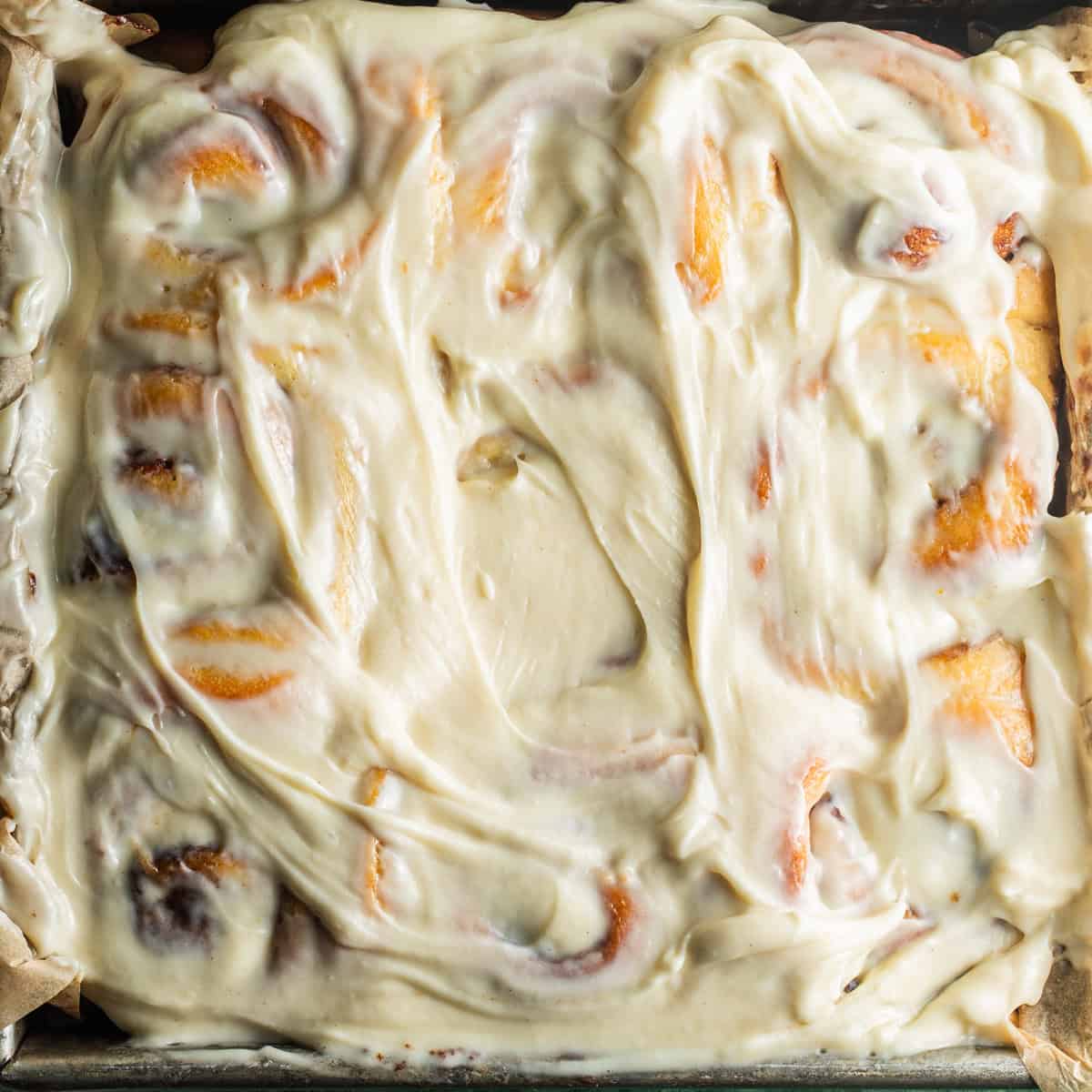








I’m not sure my last comment made it to you…
The recipe worked great! Delicious Brioche the way I experienced it in Paris.
So happy that I carried on and made them.
Thanks!
Beth
Hi Beth, so happy to hear that!! I'm really glad you did too. Again, apologies for the oversight and really happy you noticed the issue and were able to rectify it!
You left out when to add the yeast. I was carried away with following the recipe and didn’t realize I’d left it out. Added it in before the butter step. Now proofing. May be getting flat brioche.
Hi Beth,
As I mentioned to your husband, I am so sorry! I think it should be fine if you added it before the butter step, but please do let me know how it turns out. Thanks!
It did rise! Joy! Looking forward to wonderful Cinnamon Brioche Rolls tomorrow!
Thanks for your prompt reply!
My wife just finished mixing the dough and realized that the recipe left out when to add the yeast. She's going to add it now and hope for the best.
Hi there - I am SO sorry about that! I update the recipe language and it must've gotten left out. I just fixed it, and I thoroughly apologize about the mistake. Since it's the holidays, I am sending a Starbucks gift card over to you ASAP as a token of good faith.
I'd like to amend my previous review. Because the recipe had omitted the step of adding yeast, my wife had to add it later. It worked-- the cinnamon rolls did rise and the finished product was delicious. We were delighted.
Thank you so much for the prompt reply and for correcting the recipe.
Thank you so much for your follow-up and I'm so happy you enjoyed!